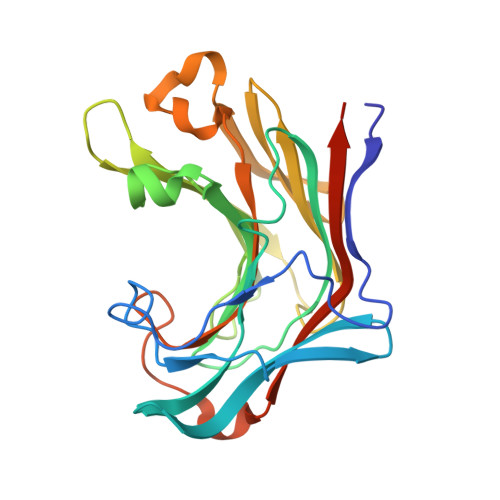Molecular Basis for Substrate Recognition and Catalysis by a Marine Bacterial Laminarinase.
Yang, J., Xu, Y., Miyakawa, T., Long, L., Tanokura, M.(2020) Appl Environ Microbiol 86
- PubMed: 32917756
- DOI: https://doi.org/10.1128/AEM.01796-20
- Primary Citation of Related Structures:
6JH5, 6JHJ, 6JIA, 6M6P - PubMed Abstract:
Laminarin is an abundant algal polysaccharide that serves as carbon storage and fuel to meet the nutrition demands of heterotrophic microbes. Laminarin depolymerization catalyzed by microbial extracellular enzymes initiates remineralization, a key process in ocean biogeochemical cycles. Here, we described a glycoside hydrolase 16 (GH16) family laminarinase from a marine alga-associated Flavobacterium at the biochemical and structural levels. We found that the endolytic enzyme cleaved laminarin with a preference for β-1,3-glycoside linkages and showed transglycosylation activity across a broad range of acceptors. We also solved and compared high-resolution crystal structures of laminarinase in the apo form and in complex with β-1,3-tetrasaccharides, revealing an expanded catalytic cleft formed following substrate binding. Moreover, structure and mutagenesis studies identified multiple specific contacts between the enzyme and glucosyl residues essential for the substrate specificity for β-1,3-glucan. These results provide novel insights into the structural requirements for substrate binding and catalysis of GH16 family laminarinase, enriching our understanding of bacterial utilization of algal laminarin. IMPORTANCE Heterotrophic bacterial communities are key players in marine biogeochemical cycling due to their ability to remineralize organic carbon. Processing of complex organic matter requires heterotrophic bacteria to produce extracellular enzymes with precise specificity to depolymerize substrates to sizes sufficiently small for uptake. Thus, extracellular enzymatic hydrolysis initiates microbe-driven heterotrophic carbon cycling. In this study, based on biochemical and structural analyses, we revealed the depolymerization mechanism of β-1,3-glucan, a carbon reserve in algae, by laminarinase from an alga-associated marine Flavobacterium The findings provide new insights into the substrate recognition and catalysis of bacterial laminarinase and promote a better understanding of how extracellular enzymes are involved in organic matter cycling.
- CAS Key Laboratory of Tropical Marine Bio-resources and Ecology, Guangdong Key Laboratory of Marine Materia Medica, South China Sea Institute of Oceanology, Chinese Academy of Sciences, Guangzhou, China.
Organizational Affiliation:

















